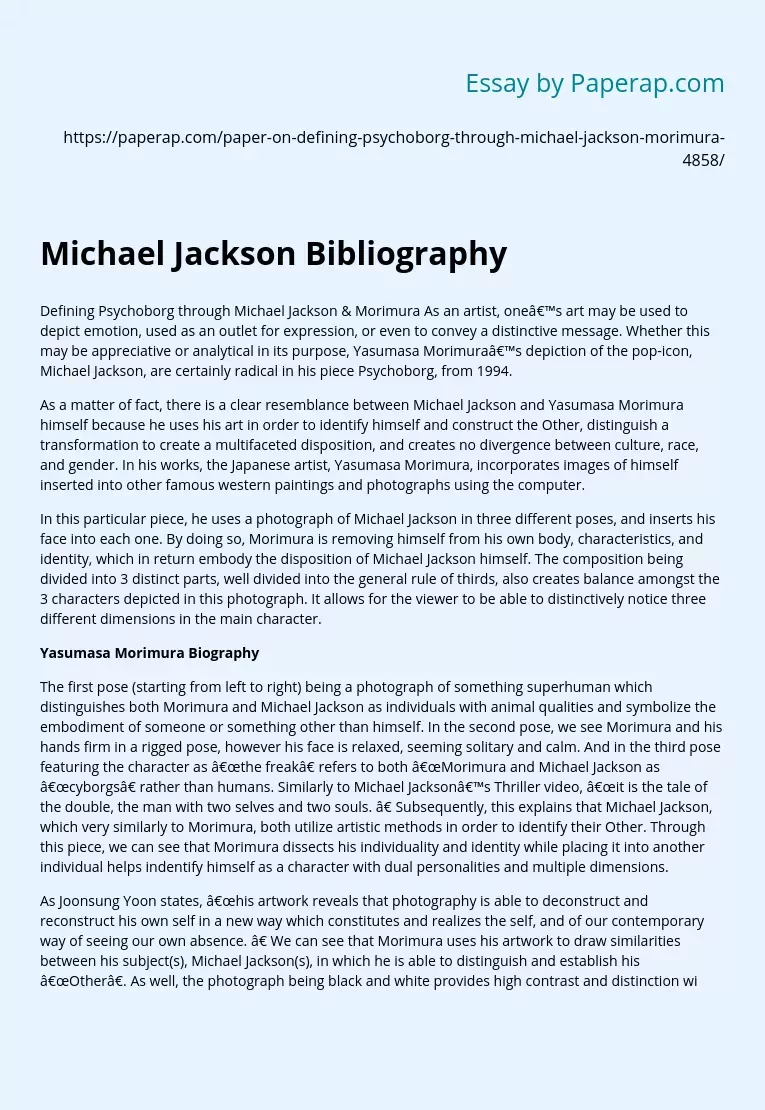Michael Jackson Bibliography
Defining Psychoborg through Michael Jackson & Morimura As an artist, one’s art may be used to depict emotion, used as an outlet for expression, or even to convey a distinctive message. Whether this may be appreciative or analytical in its purpose, Yasumasa Morimura’s depiction of the pop-icon, Michael Jackson, are certainly radical in his piece Psychoborg, from 1994.
As a matter of fact, there is a clear resemblance between Michael Jackson and Yasumasa Morimura himself because he uses his art in order to identify himself and construct the Other, distinguish a transformation to create a multifaceted disposition, and creates no divergence between culture, race, and gender.
In his works, the Japanese artist, Yasumasa Morimura, incorporates images of himself inserted into other famous western paintings and photographs using the computer.
In this particular piece, he uses a photograph of Michael Jackson in three different poses, and inserts his face into each one. By doing so, Morimura is removing himself from his own body, characteristics, and identity, which in return embody the disposition of Michael Jackson himself.
The composition being divided into 3 distinct parts, well divided into the general rule of thirds, also creates balance amongst the 3 characters depicted in this photograph. It allows for the viewer to be able to distinctively notice three different dimensions in the main character.
Yasumasa Morimura Biography
The first pose (starting from left to right) being a photograph of something superhuman which distinguishes both Morimura and Michael Jackson as individuals with animal qualities and symbolize the embodiment of someone or something other than himself.
In the second pose, we see Morimura and his hands firm in a rigged pose, however his face is relaxed, seeming solitary and calm. And in the third pose featuring the character as “the freak” refers to both “Morimura and Michael Jackson as “cyborgs” rather than humans. Similarly to Michael Jackson’s Thriller video, “it is the tale of the double, the man with two selves and two souls. ” Subsequently, this explains that Michael Jackson, which very similarly to Morimura, both utilize artistic methods in order to identify their Other. Through this piece, we can see that Morimura dissects his individuality and identity while placing it into another individual helps indentify himself as a character with dual personalities and multiple dimensions.
As Joonsung Yoon states, “his artwork reveals that photography is able to deconstruct and reconstruct his own self in a new way which constitutes and realizes the self, and of our contemporary way of seeing our own absence. ” We can see that Morimura uses his artwork to draw similarities between his subject(s), Michael Jackson(s), in which he is able to distinguish and establish his “Other”. As well, the photograph being black and white provides high contrast and distinction within the image.
This allows the viewer to be able to differentiate the background from the 3 characters themselves, which draws attention to the rigged poses of the 3 characters. This also suggests that the one character, both Michael Jackson and Yasumasa Morimura, are in or are experiencing transformation. As this piece depicts, Morimura and Michael Jackson both being: creatures, calm, and freaks as well. The artist, Morimura believes that adaptability and flexibility are both important characteristics that both he and Michael Jackson both posses.
In fact, the artist even “explained his intentions by saying he believed all people had a common desire for transformation. ” By showing the different stages through diverse and contrasting poses in this piece, the viewer is able to understand the transition of the transformation in both Morimura and Michael Jackson; Morimura specifically because he is literally in transformation through his portrait being inserted into another mans body in this photograph. Michael Jackson, however, shows this through his variety of expressions figuratively through his poses.
Therefore, through the transition of different poses displayed in Morimura’s piece, Psychoborg, it is clear that both individuals have numerous and diverse attributes, which are identified through transformation in his piece. In the piece Psychoborg, Morimura also breaks the barriers between race, gender, and culture. Yasumasa Morimura being of Japanese origin, places himself in the body form of an African American man, which transcends racial segregations. Joonsung Yoon expresses how Morimura “shuttles back and forth between Eastern and Western cultures. One side of the piece identifies the Western culture through the character’s outfit and attire. The piece also suggests Western cultural fragments because it is not a painting nor was it derived from a painting. The piece represents change within traditional Western art including paintings and drawings into a more radical contemporary movement, which include technological integrations from the computer. Morimura also chooses to incorporate himself into a worldly Western pop icon. Through this, he distinguishes no real distinction because he intertwines and incorporates both the Eastern and Western culture, virtually meshing them into one. Morimura transgresses his cultural territories from East to West…however, Morimura is not a Westerner but an Easterner. ” Through the combining of a Japanese man into an African American man’s body, we can understand the integration between cultures and races. Yasumasa Morimura’s Psychoborg is a clear depiction drawing the similarities between Michael Jackson and Morimura. Morimura’s piece is extremely effective because the message presented to the viewer take on both the literal and figurative form.
Through the incorporation of his own face into the body of another man, he uses his piece to identify his characteristics, and his identity, show a transformation through the multiple poses presented in the piece, and challenge cultural and racial differences between Western and Eastern cultures. Works Cited Margo, Jefferson. On Michael Jackson. New York: Random House, 2006. “Morimura, Yasumasa. ” Encyclopedia Britannica Online, 2009, Encyclopedia Britannica. 28 Oct. 2009 . Yoon, Joonsung. “SEEING HIS OWN ABSENCE: Culture and Gender in Yasumasa Morimura’s Photographic Self-Portraits. ” Journal of Visual Art Practice 2001. 28 Oct. 2009 .
Michael Jackson Bibliography. (2019, Dec 05). Retrieved from https://paperap.com/paper-on-defining-psychoborg-through-michael-jackson-morimura-4858/

